
Left: George Mallory and Andrew Irvine © RGS/The Sandy Irvine Trust, from "Ghosts of Everest" ; Right: 1924 North Face locations © Pete Poston
| Photoanalysis | Routes & Maps | Video & Books | Contact Me |

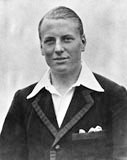
"I'm quite doubtful if I shall be fit enough. But again I wonder if the monsoon will give us a chance. I don't want to get caught, but our three-day scheme from the Chang La will give the monsoon a good chance. We shall be going up again the day after tomorrow. Six days to the top from this camp!"
--from George Mallory's last letter to his wife prior to disappearing on Mt. Everest with his partner Andrew "Sandy" Irvine in 1924
"My face is in perfect agony. Have prepared two oxygen apparatus for our start tomorrow morning".
- Sandy Irvine's last diary entry

Mallory's altimeter revisited
© Wim Kohsiek, Jan. 10, 2013
Mallory’s altimeter (manufactured by Cary, London) was found on his body by the 1999 Mount Everest Search Expedition. The pressure hand was missing but rust traces at 27850 feet and 25650 feet lead to speculations on their significance in the scope of Mallory and Irvine’s last climb (Hemmleb, 2009; Poston, 2012).
Such speculations tacitly assume that the altimeter works like present day analogue altimeters, which have an adjustable, rotating altitude scale and a fixed pressure scale. But is this true?
Altimeters of the late 19th to beginning 20th century may have a fixed altitude scale. At the edge of the instrument dial is an index that can be adjusted by rotating the bezel. For instance, see Fig. 1 of a Hicks altimeter. The resemblance between the Hicks and the Cary altimeter (Fig. 1) is striking.
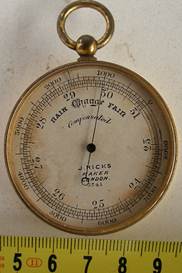 |
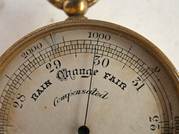 |
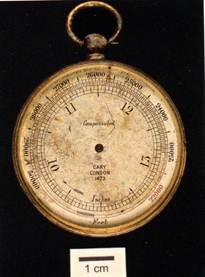 |
Fig.1. From left to right: Hicks altimeter; detail of Hicks altimeter with index at 1650 feet;
Mallory’s altimeter (from Hemmleb, 2009)
Could Mallory’s altimeter be of the same type? An inquiry at the Royal Geographical Society, where the altimeter is located, learned me that bezel can not be rotated any more because of corrosion. Other altimeters in the possession of the RGS have the same problem. However, the rust mark at 25650 feet on Mallory’s altimeter suggests an index has been there.
On July 5, 1921 Mallory and Bullock climbed the Ri-Ring near Rungbuk. At its summit the aneroid read 23450 feet, although it had been reading 400 feet low (Davis, 2011; Gillman, 1993) . The true elevation is 22520 feet, so the aneroid was reading too high instead. A mistake like this is easier to make with an altimeter with fixed altitude scale than one with a rotating scale, since you have to remember its deviation at a reference level instead of adjusting the scale.
So, there are indications that it was an instrument with fixed altitude scale. Going from there, one can derive the atmospheric model that is behind the pressure-altitude relation. To this end, I took readings of pressure and altitude from 20000 to 30000 feet. These readings follow a very simple model: an isothermal atmosphere of 282.9 K and a sea level pressure of 1013.2 mbar according to p(calcul.) = 1013.2*exp(-0.0001208z), z in m (Table, Appendix). In reality, the temperature decreases with increasing altitude (lapse rate), which leads to a more rapid pressure drop than predicted by the isothermal model. Consequently, the Cary altimeter tends to over-estimate the altitude.
Knowing the pressure-altitude relation of an altimeter, it is now possible to look at its misreading. Starting from the pressure reading, and given the pressure and temperature at some other (reference) level, as well as the lapse rate, the altitude can be calculated. The only reference available is the base camp. Pressure readings were taken daily at 08.30 am and temperature readings trice a day, be it with some interruptions. Its altitude is 16665 feet (5080 m), the atmospheric pressure varied between 540 and 560 mbar and noon temperature increased from –4 oC at the beginning of May to16 oC beginning June. Lapse rate values were derived from temperature readings at base camp and camps II, III and IV and average to -0.0079 K/m (Whipple, 1926).
The rust mark at 25650 feet and 11.62 inches pressure
This rust mark compares well with the index on my Hicks altimeter. The altitude is well below that of camp VI. Poston (2012) points out that it may refer to camp V. Mallory and Irvine were at camp V roughly between the noon of the 6th and the morning of the 7th.
The noon temperature at base camp on 6-8 June is around 15 oC. The pressure on the 7th of June at 08.30am was 16.225 inches. With these values, the calculated altitude is 25515 feet. The height of camp V is 25500 feet (Poston). The close correspondence may be fortuitous, but it strongly suggests that the index was set at camp V.
The rust mark at 27850 feet and 10.72 inches pressure
This rust mark could be the pressure hand. The altitude is at or above campVI, so we have to look at the 8th of June.
I reconstructed the pressure during the climb of 8 June. Since you need a continuous time record of the temperature and pressure at base camp, I fitted a third order polynomial through the temperature readings of June, 8 at 08:30, 12 and 16 and June, 9 at 12. The pressure was interpolated between the readings of the 8th and 9th of June (at 08:30). In the table below the results. The locations are from my idea on how the climb went (more detailed in the forum item “Odell saw them on the 2nd step”, which actually is not that appropriate a place since I have them on the 3rd step).
Table. Pressure on specific locations of M&I's climb |
|
||||
|
|
|
|
|
|
|
|
|
base camp |
base camp |
altitude |
time |
altitude |
location |
pressure |
temperature |
pressure |
|
feet |
|
inch |
oC |
inch |
5:30 |
26700 |
camp VI |
|
|
|
9:00 |
27750 |
ice axe |
16.244 |
11.6 |
10.609 |
11:15 |
28250 |
2nd step |
16.219 |
14.2 |
10.429 |
12:50 |
28575 |
3rd step |
16.201 |
14.6 |
10.287 |
13:00 |
28610 |
base pyramid |
16.199 |
14.6 |
10.273 |
15:15 |
29029 |
summit |
16.172 |
13.5 |
10.063 |
16:00 |
28610 |
base pyramid |
16.166 |
12.9 |
10.225 |
20:00 |
27750 |
ice axe |
16.121 |
7.7 |
10.465 |
22:00? |
26800 |
death |
16.098 |
4.8 |
10.816 |
24:00? |
26800 |
death |
16.076 |
2.2 |
10.757 |
2:00? |
26800 |
death |
16.054 |
0.3 |
10.713 |
The calculated pressures of the right column may be off by +/-0.1 inch, so the pressure of 10.72 inch was met either in the early morning or the late evening/night of the 8th. Since it is not likely that the altimeter was damaged in the morning, the table suggests that the pressure hand was blocked at Mallory’s fall, at some time later than 22:00. The pressure at the ice axe location is too low to be possible related to the rust mark.
The scenario I propose is then as follows: the altimeter was damaged during Mallory’s fatal fall, the glass was pressed in and the hand blocked. I presume that Wang Hongbao found the altimeter, glass and hand were lost, and he put the instrument back, so no traces of the glass and hand were found in 1999.
.
Starting from the 10.72 inch pressure, one can calculate at which altitude this pressure actually occurred on the 8th -9th of June, in other words the level of the 10.72 inch plane as a function of time. This is shown in the figure below. For instance, at 18 (6pm of the 8th of June) Mallory should have been at about 27300 feet for his aneroid to read 10.72, and so on. The horizontal line is the altitude where Mallory’s body was found. I estimate the uncertainty in the calculated altitudes at +/-200 feet. In this graph you can plot your scenario and find the time when the altimeter was blocked.
+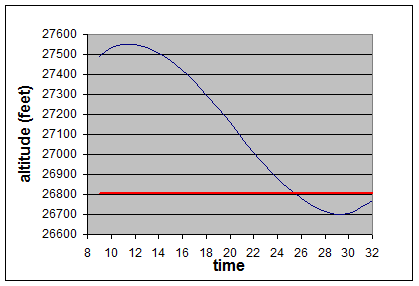
To summarize:
- Mallory’s altimeter was of the fixed altitude type with an index that could be adjusted by rotating the bezel
- The rust mark at 25650 feet is the index; it was set at camp V
- The pressure hand was blocked at Mallory’s fatal fall, which happened after 10pm on the 8th of June.
References
- Davis, W. (2011): Into the Silence, The Great War, Mallory and the Conquest of Everest. The Bodley Head, Random House, London.
- Gillman, P. (1993): The best writing and pictures of from seventy years of human endeavour. Little Brown, London.
- Hemmleb, J. (2009):Tatort Mount Everest: Der Fall Mallory. F.A. Herbig Verlagsbuchhandlung GmbH, München.
- Poston,P.(2012):Rust marks on Mallory’s altimeter. http://www.wou.edu/las/physci/poston/everest/watch2.html
- Whipple, F.J.W.(1926): The meteorological results of the Mount Everest Expedition. B. Some lessons from the observations. Q.J.R.Meteorol. Soc. 52: 136-143.
Appendix
Table. Readings from Mallory’s Cary altimeter and pressure calculated with an isothermal atmospheric model |
|||||
|
|
|
|
|
|
Cary altimeter |
|
|
isotherm |
|
|
altitude |
pressure |
altitude |
pressure |
p(calcul.) |
difference |
feet |
inch |
m |
mbar |
mbar |
mbar |
|
|
|
|
|
|
22000 |
13.305 |
6706 |
450.6 |
450.7 |
0.1 |
23000 |
12.825 |
7010 |
434.3 |
434.4 |
0.0 |
24000 |
12.365 |
7315 |
418.8 |
418.7 |
-0.1 |
25000 |
11.910 |
7620 |
403.4 |
403.5 |
0.2 |
26000 |
11.480 |
7925 |
388.8 |
388.9 |
0.1 |
27000 |
11.070 |
8230 |
374.9 |
374.9 |
0.0 |
28000 |
10.675 |
8534 |
361.5 |
361.3 |
-0.2 |
29000 |
10.290 |
8839 |
348.5 |
348.2 |
-0.2 |
30000 |
9.910 |
9144 |
335.6 |
335.7 |
0.0 |

Articles and Editorials
![]() Harvey V. Lankford, MD, has written a paper documenting the origin of the term "Glacier Lassitude" as a diagnosis for the debilitating effect of altitude as experienced by members of the early British Everest expeditions.
Harvey V. Lankford, MD, has written a paper documenting the origin of the term "Glacier Lassitude" as a diagnosis for the debilitating effect of altitude as experienced by members of the early British Everest expeditions.
![]() My new theory about Mallory and Irvine's last climb, where I believe Odell's sighting was erroneous, and have them taking the Couloir route instead.
My new theory about Mallory and Irvine's last climb, where I believe Odell's sighting was erroneous, and have them taking the Couloir route instead.
Part 1: the ascent
Part 2: the descent
![]() Warwick Pryce is a new researcher who has arrived on the scene, and he has a new theory about how Andrew Irvine could have been the first person to stand on the top of the world.
Warwick Pryce is a new researcher who has arrived on the scene, and he has a new theory about how Andrew Irvine could have been the first person to stand on the top of the world.
Wim Kohsiek has a new interpretation of what Mallory's altimeter can tell us based on scientific applications of meterology.
Mallory and Irvine researcher Wim Kohsiek has two new thought-provoking articles about Mallory's watch and Irvine's location:
Mallory's Watch - Does it Really Point to 12:50 PM?
1924 Oxygen by Richard McQuet and Pete Poston
Why the Camera and Film are not Doomed to Destruction!
The Politics of Mallory and Irvine
Why Andrew Irvine Will Not be Found in a Sleeping Bag! Part 1 and Part 2 on ExplorersWeb
Chomolungma Nirvana: The Routes of Mount Everest
Rust Marks on Mallory's Altimeter
Mystery of Mallory and Irvine's Fate Google Earth Tour - my own ideas in 3-D with audio!
Little Known Free-Solo Ascent of the Second Step in 2001 by Theo Fritsche - I should never have written this - Anker and Houlding deserve credit for the first free ascent
Criticisms of the 2004 EverestNews.com search for Irvine --
The Mystery of Mallory and Irvine's Fate (with J. Hemmleb): Part 1, Part 2, Part 3, Part 4, Part 5.
Mallory and Irvine - Comments on the 'real Second Step' route: Part 1 and Part 2
Conrad Anker's comments on the unlikeliness of a direct route up the prow of the 2nd Step
Articles about my heroes Walter Bonatti and Chris Bonington --
Spilling the Beans - Lino Lacedelli's Book "Price of Conquest: Confessions from the First Ascent of K2" Part 1 and Part 2
The Life and Climbs of Chris Bonington, Part 1, Part 2, Part 3, Part 4, Part 5 final - interview
About Me
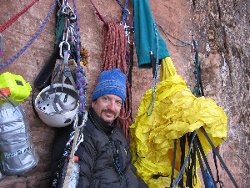 Celebrating my 50th birthday on pitch 3 of Prodigal Son, Zion National Park, Utah
Celebrating my 50th birthday on pitch 3 of Prodigal Son, Zion National Park, Utah
In my free time, I love to photograph and hike the spectacular redrock wilderness of the Colorado Plateau - please visit my Colorado Plateau Homepage.
And for most of my life I've been fascinated with the history, people, and culture of the Himalayas and Karakoram - browse my Mount Everest Trek (1996), Overland Journey from Kathmandu to Lhasa (2000), and K2 Base Camp Trek (2007) webpages.
As for my employment, I work for Western Oregon University where I have been a Professor of Chemistry for the last 20 years. My research interests are in applications of Laser Raman Spectroscopy to such diverse fields as Nanotechnology, Analytical Chemistry, and even a bit of Achaeology through the study of rock art pigments found in the Colorado Plateau. You can access my academic webpage here.

Copyright (c) 2004-2022 Pete Poston. All rights reserved. Visitor's Agreement |